Temple of Edfu
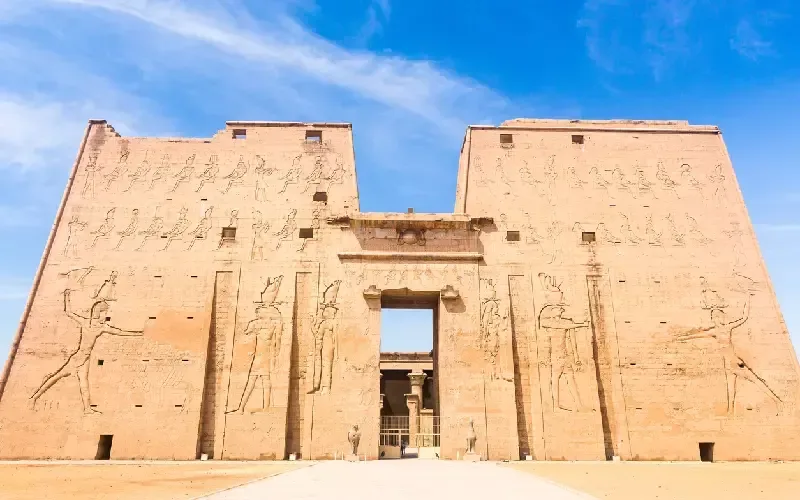
The Temple of Edfu, one of the best-preserved monuments in Egypt, was buried for centuries under nearly 40 feet of sand and Nile silt. Built during the Ptolemaic period between 237 BC and 57 BC, it stands as a monumental structure dedicated to Horus of Behdet, Hathor of Dendera, and their son Harsomtus. The temple holds deep mythological importance as the legendary site of the battle between Horus and Set. Today, its exceptional preservation offers valuable insight into ancient Egyptian religion, architecture, and cultural life.
Beyond its historical importance, the temple now serves as one of the most visited sites in Upper Egypt, drawing travelers from around the world who are eager to witness its grandeur and detailed inscriptions. As you walk through its towering gateways and shadowed halls, you can feel the weight of centuries of worship, ritual, and artistry that still echo through its stones.
If you’re exploring what sets it apart, the Temple of Edfu is considered the best-preserved of all ancient Egyptian temples. Its remarkable condition lets you clearly see Ptolemaic religious traditions, architectural methods, and inscriptions. Because it stayed buried under layers of sand and silt for centuries, it was shielded from damage, giving you an unusually complete look at a functioning ancient temple.
The Origins of the Temple of Edfu
The Temple of Edfu represents one of the most significant architectural achievements of the Ptolemaic era in Egypt. Standing majestically on the west bank of the Nile, this monumental structure offers an extraordinary window into the religious practices and architectural prowess of ancient Egyptian civilization.
What makes its origins particularly fascinating is how it bridges different eras of Egyptian history. Although constructed during the Greek-ruled Ptolemaic period, the temple fully embodies the spirit and traditions of earlier pharaonic temples, creating a unique blend of cultural continuity and political strategy.
Construction under the Ptolemaic Dynasty
The Ptolemaic dynasty, founded by Ptolemy I Soter (a former general of Alexander the Great), ruled Egypt for nearly three centuries. Throughout their reign, they commissioned several impressive temples, including those at Dendera, Esna, Kom Ombo, and Philae. This ambitious building program reflected both the dynasty's prosperity and their strategic efforts to integrate themselves into Egypt's religious landscape.
Although the Ptolemies were of Macedonian origin, they deliberately embraced traditional Egyptian architectural principles when constructing the Temple of Edfu. This calculated decision helped them gain legitimacy among the native population by honoring indigenous deities and cultural practices. The temple's massive scale—covering approximately 7,000 square meters and stretching over 140 meters in length—demonstrates the considerable resources available during this period.
What makes the Temple of Edfu particularly remarkable is its thoroughly Egyptian character, despite being built under foreign rule. The Ptolemaic rulers maintained fidelity to traditional Egyptian temple design, creating a structure that preserved both form and function with exceptional authenticity.
Why Edfu Was Chosen as the Site
The selection of Edfu as a temple location was rooted in both historical precedent and religious significance. Archeological evidence indicates the existence of earlier sacred structures at this site dating back to the Third Dynasty. Additionally, inscriptional evidence reveals a previous building program under New Kingdom rulers Ramesses I, Seti I, and Ramesses II.
Furthermore, the earlier temple on this site was also dedicated to Horus, although it was oriented east–west rather than the north–south alignment of the current structure. This established religious connection to Horus made Edfu a natural choice for the Ptolemies' grand temple project.
Edfu held profound mythological importance as well. The site was associated with Horus of Behdet (also called Behdety), a significant manifestation of the falcon god. As a center for Horus worship, Edfu became one of Egypt's most important religious sites during the Ptolemaic period.
The choice of site also positioned the temple along key trade and pilgrimage routes, making it a central point for cultural exchange and religious gatherings.
Timeline from Ptolemy III to Ptolemy XII
The construction of the Temple of Edfu spans several generations of Ptolemaic rulers:
- 237 BCE: Construction began under Ptolemy III Euergetes I on August 23rd, with the initial structure consisting of a pillared hall, two transverse halls, and a barque sanctuary surrounded by chapels.
- 142 BCE: Ninety-five years after groundbreaking, Ptolemy VIII Euergetes II officially consecrated the temple in a ceremony attended by the king and his wife.
- 140 BCE: Construction progressed to include the pronaos, pylon, and surrounding wall.
- 70 BCE: Ptolemy XII Neos Dionysos conducted the second major consecration ceremony.
- 57 BCE: Installation of the grand wooden entrance doors marked the temple’s completion.
Throughout this extended construction period, the Ptolemies maintained consistent architectural principles and religious symbolism, creating a harmonious structure that stands as the finest surviving example of Ptolemaic temple architecture in Egypt.
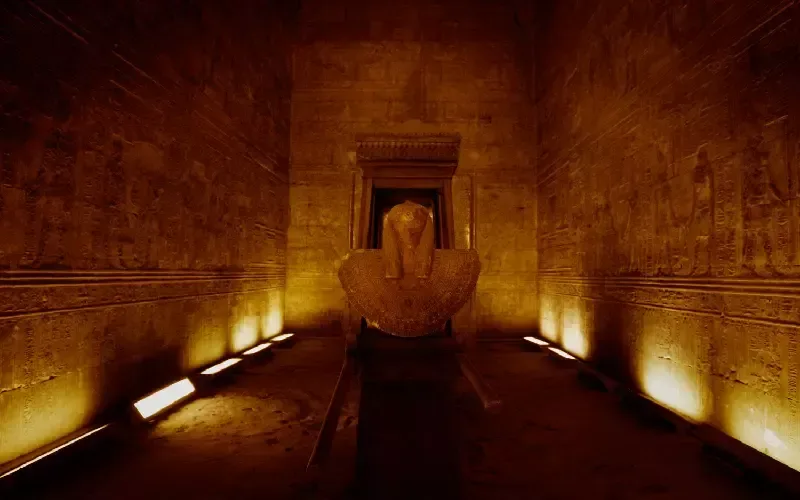
Architectural Brilliance of the Temple of Horus
The architectural elements of the Temple of Horus at Edfu offer unparalleled insights into Ptolemaic construction techniques and religious symbolism. This exceptionally preserved structure showcases the masterful integration of traditional Egyptian designs with subtle Hellenistic influences.
The Towering Pylon and Its Symbolism
The monumental entrance pylon stands at an impressive 36 meters, dominating the skyline of Edfu. Completed under Ptolemy XII, it features two massive towers carved with imagery of the king smiting enemies—an ancient Egyptian symbol of royal power and divine protection.
Two colossal granite falcon statues of Horus guard the entrance, immediately establishing the temple's sacred atmosphere.
Hypostyle Hall and Astronomical Ceiling
Inside the Great Hypostyle Hall, 12 massive columns rise toward a beautifully decorated ceiling covered in astronomical motifs. These images served as symbolic connections between earthly worship and the heavens, reinforcing the idea that the temple was a microcosm of the universe.
The Sanctuary and the Granite Shrine
At the heart of the temple lies the sanctuary, housing Nectanebo II’s black granite naos—older than the temple itself. This sacred chamber once contained the golden cult statue of Horus and served as the spiritual center for daily rituals conducted by priests.
The Mammisi: Divine Birth House
Positioned beside the main temple, the mammisi (birth house) celebrates the divine birth of Harsomtus. Its walls depict rituals of divine motherhood, fertility, and renewal, playing a crucial role in the temple’s ceremonial cycle.
Use of Sandstone and Granite
The builders carefully selected materials—sandstone for the main structure and granite for symbolic elements like statues and shrines. Their mastery of stone-cutting and carving is evident in every part of the temple.
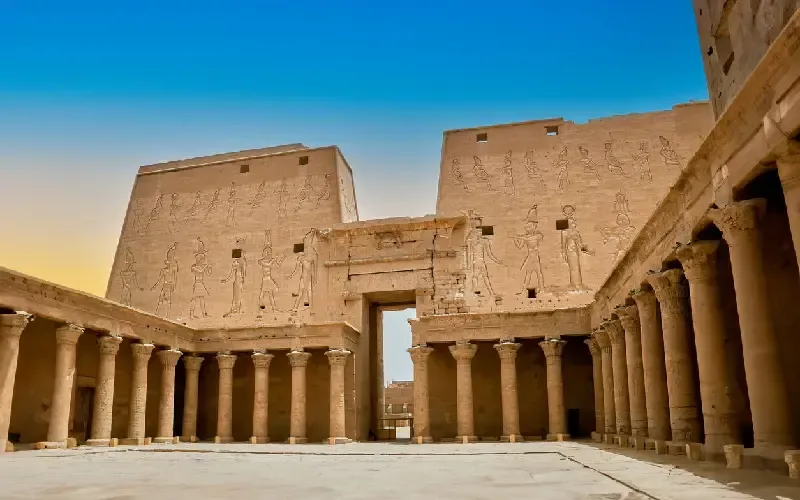
Customize Your Dream Vacation!
Get in touch with our local experts for an unforgettable journey.
Plan Your Trip
The Mythological Foundation of the Temple
The temple’s mythology intertwines with cosmic creation stories and the eternal struggle between divine forces.
The Battle Between Horus and Set
Edfu is believed to be the site where Horus defeated Set, symbolizing the triumph of order over chaos. Scenes of their battles are carved throughout the temple, chronicling this cosmic struggle in vivid detail.
The Role of Ptah and Thoth in Creation
The temple inscriptions describe the universe emerging from primordial waters, with Ptah and Thoth shaping creation through thought, speech, and divine architecture.
The Falcon as a Symbol of Divine Order
Horus’s falcon form represents kingship, vision, and celestial power. This symbolism reinforced the pharaoh’s sacred role as Horus’s earthly embodiment.
The Stretching-the-Cord Ritual
This foundational ceremony, led by Seshat, marked the laying of the temple’s sacred boundaries and aligned the structure with the stars, reinforcing cosmic harmony.
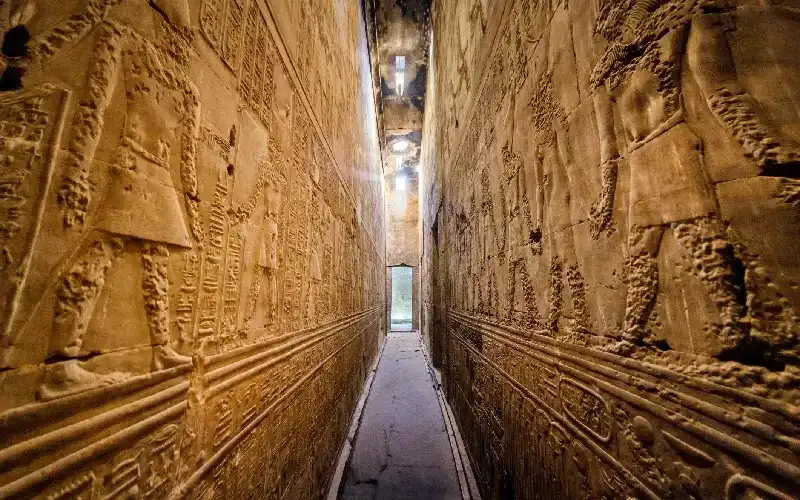
If you’re interested in the mythology, the Temple of Edfu stands on the site believed to have witnessed the legendary battle between Horus and Set. This gives the temple a deep symbolic meaning, showing you how the ancient Egyptians connected it to the cosmic struggle between order and chaos, reinforcing both divine authority and royal power.
Religious and Cultural Significance
Annual Festival of Horus and Hathor
The Beautiful Reunion festival celebrated the marriage of Horus and Hathor. Hathor’s statue traveled from Dendera to Edfu, where grand rituals, music, and offerings filled the city with celebration.
The Edfu Triad
The divine family—Horus, Hathor, and Harsomtus—represented fertility, kingship, and unity. Their worship formed the foundation of Edfu’s religious identity.
Rituals and Daily Worship
Daily offerings, hymns, and sacred barque processions connected priests and believers to the divine realm. The temple functioned as a living center of spiritual activity for centuries.
Rediscovery and Preservation of the Temple
After the banning of pagan worship in the 4th century CE, the temple fell silent and was gradually buried in sand and silt. Homes were even built above it.
Mariette’s Excavation
In 1860, Auguste Mariette excavated the site, revealing an astonishingly intact temple, protected for over a millennium by the very sands that hid it.
Modern Preservation
Ongoing conservation efforts continue to restore original colors, protect reliefs, and improve visitor access, ensuring the temple remains one of Egypt’s most remarkable ancient monuments.
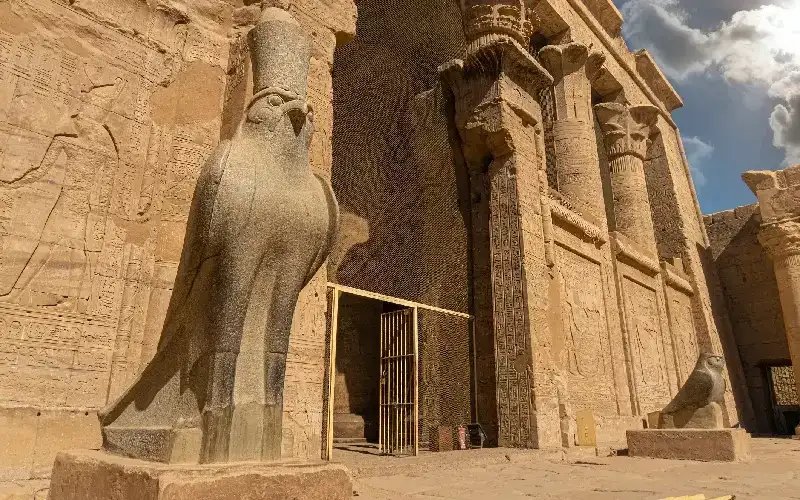
When you look at its construction timeline, you’ll find that building the Temple of Edfu took 180 years. Work began in 237 BC under Ptolemy III and ended in 57 BC under Ptolemy XII. This long span of time shows you how several generations maintained the same design and religious purpose throughout the project.
When you read about its celebrations, the most important one is the Feast of the Joyous Union—also called the Beautiful Reunion. This 15-day festival honored the sacred marriage between Horus of Edfu and Hathor of Dendera. It lets you imagine the elaborate processions, rituals, and festivities that once filled the temple.
The temple became buried gradually as desert winds carried sand across Upper Egypt while annual Nile floods deposited layers of silt. Over time, homes were even built above the hidden structure. This natural burial accidentally protected the temple from weathering and looting, preserving it in near-perfect condition until its excavation in the 19th century.
The temple was identified by a French expedition in the late 18th century, but its full excavation was carried out in 1860 by the Egyptologist Auguste Mariette. His team removed thousands of tons of sand and debris, revealing an exceptionally intact temple that became one of the most important archaeological discoveries of its time.
The Temple of Edfu served as an active center of worship where priests performed daily rituals, presented offerings, and tended to the sacred image of Horus. These ceremonies followed strict traditions and took place every morning, afternoon, and evening, reinforcing the connection between the gods and the people of Edfu.
The temple was primarily constructed from sandstone quarried in the region, chosen for its durability and ease of carving. Granite was used only for special elements such as the statues of Horus and the sanctuary’s shrine. This combination of materials allowed craftsmen to create detailed reliefs while ensuring structural strength.





























